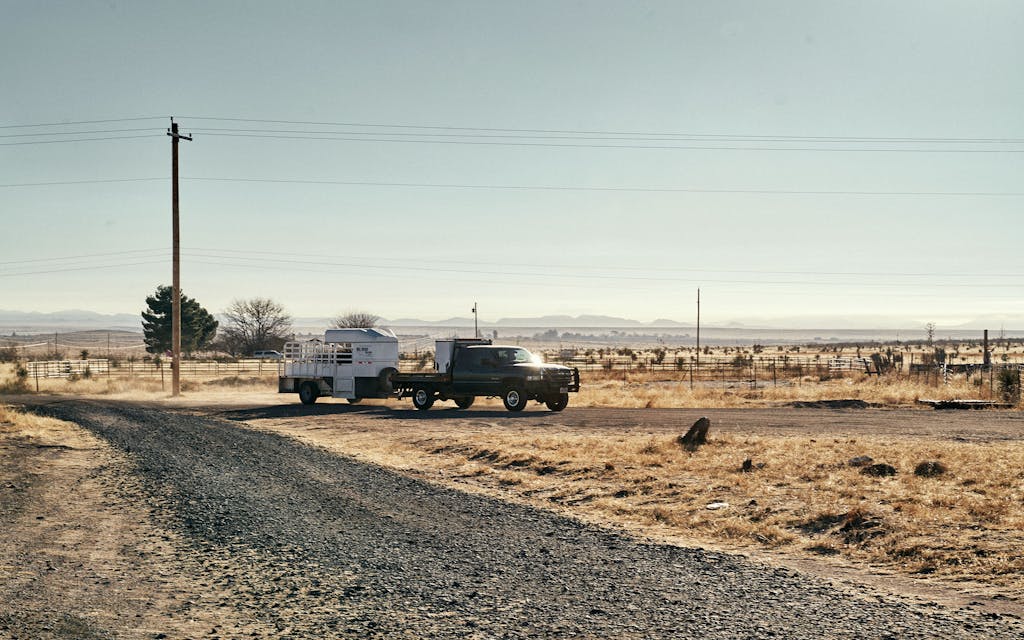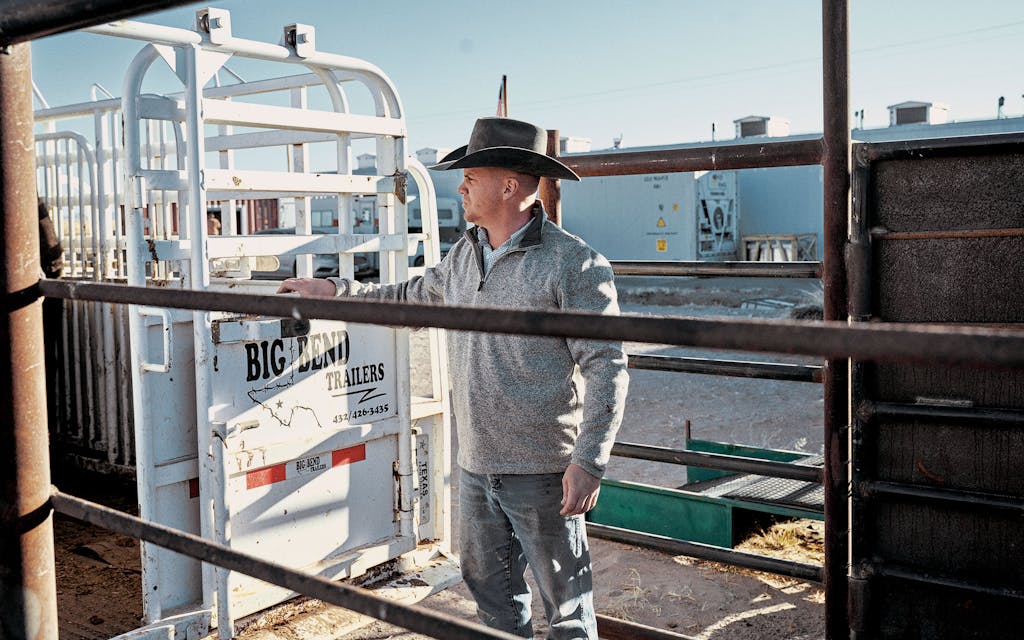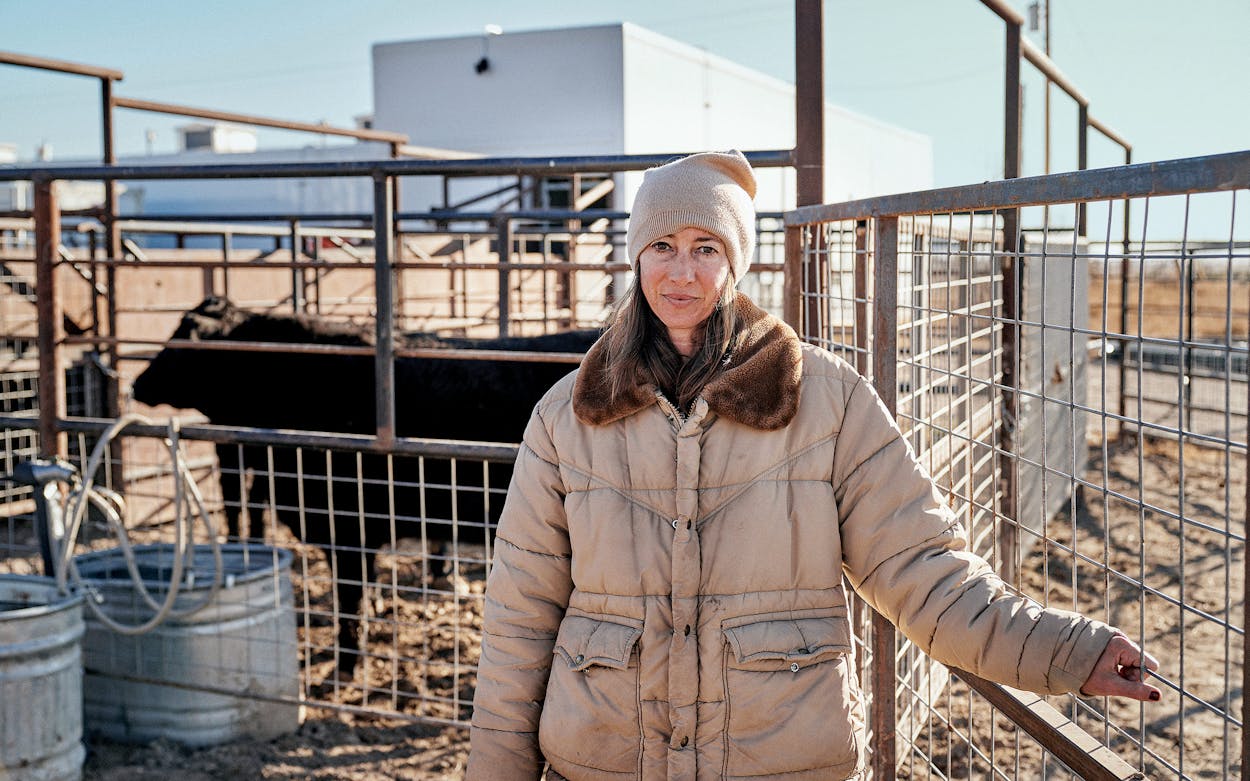A black Corriente steer looks around the unfamiliar holding pen and gives his tipped horns a shake. Christy Miller, the owner of Marfa Meats, watches from outside the pen, holding a coffee cup. Her brown hair is pulled into a messy bun, and she wears an oversized cardigan and leggings. The steer’s owner, in his Carhartt coat, clanks closed the livestock trailer’s gate. Miller’s Australian shepherd barks rhythmically from a yard nearby.
The Corriente eyes Reine Conrad, Miller’s slaughter manager, who stands in the pen and holds a flag of blue fabric affixed to a rod. Conrad flaps the flag at the steer, urging it into a smaller enclosure with a scale on the ground. A tattoo of a butcher’s pork diagram peeks out from the sleeve of her New Zealand Rugby shirt. “Shh, shh,” she tells the steer as she waggles the flag. “Hey, hey. Oy. Hey, hey.”
The steer considers her. He considers the enclosure in front of him. There is no hurry. He steps forward, onto the scale: 754 pounds.
Miller converses briefly with the steer’s owner. “He’s gonna keep all the offal,” Miller calls to Conrad.
“Everything?” Conrad asks. “You want the head whole, or just tongue and cheeks?”
“Tongue and cheeks. I was gonna see if there’s a way to keep that skull and horns, maybe,” he says. “Y’all ever do that?”
“I can give you the entire head back and strip off all the usable meat for you,” she says.
“Yeah. That’d be great.”
The owner rumbles off in his diesel truck. The two women nudge the Corriente through a set of pens until he walks up a ramp and into a modular building, where the door slides shut behind him. He occupies a chute facing Conrad. She holds a captive bolt gun, and a long-bladed knife hangs from her hip. She takes a moment to rub his woolly forehead. The steer is quiet, and his eyes show no alarm; his end is swift and adroitly executed. His blood as it leaves his body steams in the refrigerated air.

Miller opened Marfa Meats in the summer of 2021. It was the first livestock slaughter and processing plant, other than a teaching facility at Sul Ross State University, to operate in the Big Bend in decades. Though she is now steeped in the art and business of butchering, Miller, who is 47, has little background in agriculture. She grew up in Indiana and attended Indiana University, earned an MBA at the University of Oxford, and spent 25 years as a financial software consultant based in Denver. “I love project-based work—the definitive start and end,” she explains. “You have a baby for nine to sixteen months, and then you give it away.”
What that work lacked, however, was a human element. “Being able to connect with people is so critical to my satisfaction,” she says. Between consulting contracts, Miller traveled. A road trip in 2015 took her through Marfa, and the town charmed her so much that she began living there for part of the year. By 2017 she was spending more time in Marfa than in Denver, thinking about career possibilities that would allow her to make the change permanent. “I just like it here,” she says. “It’s so freeing. I don’t inadvertently get spun up on things that aren’t important to me.”
And then came Ellery Aufdengarten. Ellery and his family had run a Big Bend cow-calf operation for years. He’d first landed in the area from Nebraska in the late seventies to rodeo for Sul Ross. “He met my mom, Debbie, through friends, and that was that,” says Mitch Aufdengarten, one of Ellery’s sons. “He helped my granddad and worked for a few ranches, then struck out on his own.” Ellery was given to forming unlikely friendships—a painter who stopped in Marfa and never left, for instance, or a trespassing Scottish photographer whom Ellery caught snapping pictures on his land. “People were just drawn to him,” says Mitch. “He was genuinely interested in whatever anybody wanted to talk about.”
The painter friend introduced Miller to Ellery, and she soon put forth to him a question that had been rolling around in her mind. Why is it that we’re surrounded by cattle but we can’t buy local beef at a store or restaurant? Maybe, Ellery said, you should open a locker plant.
Perhaps a few thousand small-town, small-volume locker plants existed in Texas at the start of the twentieth century. These were places that slaughtered and processed a steer, pig, or sheep that a family had fattened for themselves. “In my hometown of Dobbin and nearby small towns, we took our livestock to the local processor, and that meat would feed not just our family, but we shared two hogs with five other families,” says DeMetris Reed Jr., a Sul Ross meat science professor.
Over the decades, Reed says, younger generations stopped following their grandparents into the family locker-plant business. Regulations for livestock processing grew complicated. Boxed beef became common. Grocery stores became more accessible. Most folks too prefer roasts, ground beef, or steaks over, say, kidneys, livers, or the viscera that comes with butchering an animal. “If you can pick what you want, leave the rest, and skip raising an animal—that will close a small processor eventually,” says Reed. “Middle meats and ground beef can’t pay the cost of offal disposal these days. Large plants have markets for what the average American wants to eat.” Many small-scale locker plants simply disappeared.
Yet clearly there are still cattle, and lots of them. Miller’s back porch overlooks tens of thousands of acres of rolling yellow grassland dotted with grazing cows. She couldn’t get over the fact that almost all the cattle in the Big Bend were bound to be sold and trucked to huge feedlots and packers in the far-distant Panhandle. Local ranchers, she realized, would never knowingly find their own beef at their own hometown grocery or restaurant. “In our tri-county area, the last time they did an agricultural census, there were eighty-four thousand cows,” she says. “How could we be in a position where we have eighty-four thousand cows roaming around here and none of these ranchers get to taste the fruit of their labor? We should all have the opportunity to eat food that is raised here.”


In January 2020 Miller attended a butchering workshop in Brooklyn, where she helped break down an entire cow. “It’s hard work,” she says. “You’re not knowing what the hell you’re doing and not wanting to screw up.” Undaunted by the gore and the work’s physical nature, she audited a Sul Ross class on slaughter and processing where Reed was among her mentors, and she volunteered at the school’s meat lab. “The first time I got a cow’s head off, I was like, ‘Yes!’ ” she recalls.
At every step—thinking about the local beef issue, learning to slaughter, learning to butcher—Miller’s interest in opening a processing plant grew keener. She could handle the regulations. Marketing she could nail. Creating this business seemed possible. “You know how it is out here,” Miller says. “If you’re not able to do it yourself, then you’re at risk of not having it happen at all.”
Ellery was her greatest advocate and enabler. As Miller rode around looking at prospective sites, Ellery sat next to her in the truck, doling out advice and listening to her dream aloud. “I was asking all these questions,” she recalls. “ ‘Is there any money in this?’ ‘If this is going to happen, where?’ ‘Can you help me find a place?’ We had all kinds of adventures figuring out where that would be. Once he realized I was really going to do it, he literally started telling everyone what I was doing. His way of scooping you up and taking you forward was something to behold.”
Her inexperience did not go unnoticed. Yet ranchers—whose livelihoods depend upon rain, the caprice of large animals, and unreal quantities of hard work—are innate optimists who admire persistence. “I love her to death, but at the time, she had absolutely no business running a meat processing facility,” says Mitch. “Christy is very business-savvy, and she saw a need. There’s absolutely no whoa in her. For better or worse, she and Dad fed off each other.”
Miller dove into visiting and researching small processing plants during the summer of 2020. She was actively looking for a site, exploring financing, and still consulting to support herself. One July day, Ellery died suddenly, of natural causes, while horseback. He was just 62 years old. Miller was rocked by the loss, in part because his death endangered a dream that the two had shared but never instituted: To take good Angus cattle bred in Presidio County, doctored, branded, tended, and allowed to freely roam and grow on this high grassland plain, and then slaughtered, processed, packaged, and sold just a few miles from where they were born. Not anyone’s cattle. Ellery’s cattle. “I wasn’t interested in finding any random source for beef,” Miller says. “I wanted to do it because Ellery said, ‘I want to sell my beef to the people, and I want to see my name on a label.’ And I said, ‘Well, if that’s possible, let’s do that.’ We were a team. And it fell on my shoulders to bring it to fruition.”

Mitch and his brother, Gerry, weren’t familiar with the details of their father’s plan with Miller, but shortly after his death, the two went to her. “I don’t know what y’all got planned,” Mitch told her. “Whatever my dad was gonna do with you, we still want to.”
Miller shakes her head, remembering that pledge. “Those guys, they inherited me,” she says. “They just embraced me. Countless days, they were here building pens, helping me figure out one thing or the other.”
She bought a place a few miles west of Marfa, liquidating a property she owned for up-front money. She secured a lender, obtained permits, and hired a manufacturer to fabricate the facility’s custom modular units: a kill room, a dry-aging cooler, and a cut-and-wrap shop. These boxcar-size, white-clad units, set in an L shape, sit humming a few hundred feet from her house. An acquaintance from the meat lab at Sul Ross, who had become a USDA inspector, introduced her to Conrad, a butcher and biologist who’d taken meat science coursework and was working at an Alpine liquor store before Miller hired her. A research trip to a Colorado butcher shop yielded Nicole Tancik, whose background and ambition dovetailed into a job as Miller’s production manager. Friends contributed advice and moral support. Local folks eager to learn a trade beyond Marfa’s service industry applied for jobs.
Timing was on Miller’s side. Meat shortages during the early months of the pandemic drove customers to look beyond grocery stores. The Aufdengartens fielded calls asking whether they had spare meat to sell from their personal freezers. Small meat lockers in Texas remain booked and busy, in part because of the pandemic, says Reed, the Sul Ross professor. “The greatest movement that came out of the meat shortage of 2020 was ‘Buy Local Beef,’ ” he says. “Beef raised, harvested, sold, and consumed in Texas is a step in the right direction of closing the gap between consumers and those involved in production agriculture. The gap from rancher gate to consumer plate has been far too great for the past three generations.”
Marfa Meats slaughtered its first animal, an old bull, in May 2021. “We learned a lot from that one,” Miller says. “We’ve got it down at this point. We can do five a day on the slaughter side of the business and three a day on the cut-and-wrap side. We’re improving as people get trained up.” Marfa Meats now offers custom processing for clients with wild game or home-raised animals, like the Corriente steer, intended for personal consumption. A USDA inspector is present for livestock raisers who bring cattle, goat, swine, or sheep intended for retail sale. Producers also supply animals to Miller that are processed and packaged under the Marfa Meats label and sold at her retail counter or from a freezer at Cactus Liquors in town, or distributed to Big Bend restaurants.
Aufdengarten beef is central to the operation. Traditionally, cow-calf operations sell weaned calves to stockers, who pasture-feed them for a time. They’re next moved to a lot where they’re fattened for a hundred days or more. Then it’s on to a packer for slaughter and processing before the packaged beef is shipped out to grocers. That’s a lot of steps, and it means that ranchers may never know the quality of their own beef or where it ends up. With Marfa Meats, the Aufdengartens now keep about fifty animals at a feedlot they maintain west of town, using a custom ration to finish out the calves. Two or three calves are sent to Marfa Meats every week. New calves from the herd on the range are then brought to the feedlot. “Those steers are born and raised and killed right here in Presidio County,” Mitch says. “I’m proud to be able to do that and know where that beef is going.”
The difference is evident in the quality of the meat, says Miller. The price is higher than for typical grocery store fare—bone-in ribeye from Marfa Meats is $34 a pound—but she insists it’s worth it. “It’s way better,” she says. “It’s a different product almost. The transport time is so low that the cattle are not stressed on a truck. The meat goes into our freezer, and you buy it. If you buy meat at the store, it’s been frozen and unfrozen, transported here, transported there—who knows how many hands have touched it and what’s happened to it.”
Miller is cogitating on how to get Marfa Meats farther afield—to restaurants outside the region, in subscription or mail-order boxes, or perhaps in high-end urban supermarkets. That will take more research, more money, and more experimenting with how to get a consistent flow of livestock through her production line. “If we get the volume, eventually it’ll be a nice little business,” she says. “The goal is to be profitable serving the local community—making sure we can satisfy processing needs here and also making West Texas beef something people seek out.”
There is a lot on the line. Miller’s deep financial investment, the Aufdengartens’ efforts, the weight of responsibility for her six employees—they all originate from that single question she posed to Ellery and her willingness to follow her own curiosity. The reasons why Marfa Meats must work are intensely personal. “I never felt like I was doing anything that mattered much,” she says. “There are a lot of consultants who could do what I was doing. But there aren’t that many people who saddle up for this kind of ride.”
It’ll be worth it, she says, if a certain moment can happen. She wants to sit down at a big-city restaurant and order a particular steak. “I want to see Ellery’s name on a menu at a fancy place,” she says. “If we can have menus at fancy restaurants that say ‘Aufdengarten Cattle Company,’ that would make him happy. That’s what I want.”
This article originally appeared in the March 2022 issue of Texas Monthly with the headline “Bred in the Bone.” Subscribe today.








